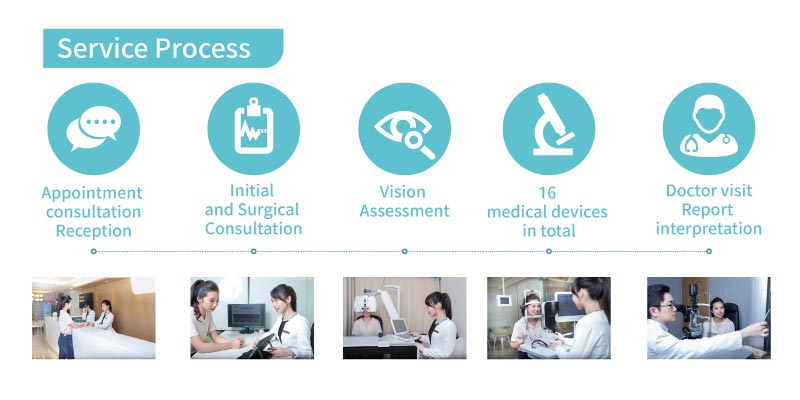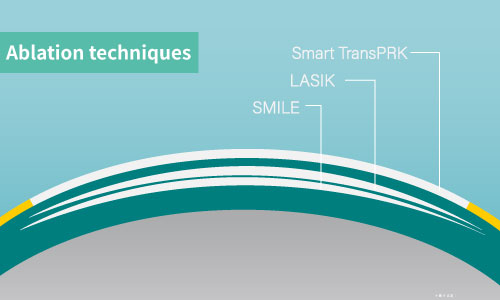“Myopia” has been a persecution for most people in Taiwan, besides the affected vision, long-term wearing of glasses with the compression on the ears and bridge of the nose from the heavy frame also cause much discomfort, even leading to frequent headache. The National Health Interview Survey indicates that for Taiwanese adults, the myopic ratio is as high as 85% in college-and-above students, the ratio is quite amazing. In addition to wearing glasses and contact lenses, choosing Laser Eye Surgery for vision correction has been a popular option the past years. Nevertheless, some people may worry about safety issue of Laser Eye Surgery, and the choosing criteria for a suitable one among various Laser Eye Surgery operations.
Are you suitable to receive Laser Eye Surgery?
The ideal age for Laser Eye Surgery ranges between 20 and 50, the physician will evaluate patient’s eye to see if appropriate to perform PRK, the procedure may be proceeded only after confirmation of no any other ocular diseases except myopia or the physiological structure complying with surgical requirements.
According to the Assistant Manager of Clinical Research for WishVision, Chen Si-Ru, for patients expecting to receive Laser Eye Surgery, in addition to explaining the procedure, preoperative examinations are the most important issue. There are roughly 16 items of test conducted using precise instruments, which is just like first performing a comprehensive health examination for the eyes. The examination consists of two parts, one is conditions of physiological structure, and the other involves examination for ocular disease.
The physician indicates, with the acceptable results after preoperative evaluation, anyone who feels necessary may receive Laser Eye Surgery but most preferably at ages between 20 and 40.

Criteria for physiological structure primarily involve 3 indicators, corneal thickness, pupil diameter and myopia diopter, the three are closely linked with one another. Chen Si-Ru states, “Laser Eye Surgery refers to the surgery performed on the site of the cornea, adjusting corneal structure to let light beam enter into the fundus for imaging at correct location, which therefore requires for evaluation of the sufficient thickness of patient’s cornea. In Laser Eye Surgery, corneal thickness is generally recommended to be more than 280 μm, to maximize safety for the surgery, conscientious and careful physicians may prefer a bit thicker, more than 300 μm would be safer.” Additionally, Chen Si-Ru also explains that for patients with larger pupil and higher myopia, it would be required to excise relatively more portion of the cornea during the surgery, thus on measurement, only the thicker cornea may be performed laser vision correction.
On the other hand, ocular disease is an item for evaluation too. If any conditions were found in the examination such as glaucoma, retinopathy including retinal edema and retinal detachment, the patient always will be recommended to primarily treat the illness. Only after the treatment completed, the physician may start to evaluate and discuss with the patient the necessity for Laser Eye Surgery, explaining surgical risk to the patient.
“Patients with premature glaucoma have been commonly found!” Chen Si-Ru indicates, with inappropriate habit in use of the eyes, and heavily using computer, communications and consumer electronics, certain percentage of patients expecting to receive Laser Eye Surgery may be identified to be with other conditions. “After precise tests performed by the physician, some patients unsuitable to receive Laser Eye Surgery may be screened. Because WishVision adopts stricter evaluation criteria, there is only 50% of patients suitable for the surgery after screening.” For the physicians attaching importance to patient’s eye health and vision safety, they would set higher level of preoperative specifications and criteria for more protection of the patients.
Laser Eye Surgery Comparison
Laser Eye Surgery may be categorized by the presence of producing corneal flaps (making an incision in the circular strip of the outer corneal tissue in the operation) or the depth in corneal ablation. Benefits for operations involved producing corneal flaps include rapid postoperative recovery, milder painful sensation, but because of the slower wound healing on the excision surface, consequent complication risks such as corneal flap deviation are more commonly found resulted from doing exercises, lifting heavy objects or impact accidents; on the other hand, in operations without producing corneal flaps, though it takes a longer time for recovery, consequent risks in eye conditions are relatively lower due to the better wound healing; for the area regarding ablation depth, the mainstream operations for corneal ablation in sequence from shallow to deep are: the shallowest in Smart TransPRK, followed by Smile LASIK, with the deepest in ReLEx-smile or Smile. Ablation depth may affect the postoperative residual thickness of the cornea, the thicker cornea reserved correspondingly provides more stable corneal structure.

2015 Zero-contact Smart TransPRK (without producing corneal flaps, surface ablation)
- Operative procedure: Excimer laser is used for ablation of the corneal epithelium in one step, performing diopter correction, operation is conducted using automatic instruments during the entire procedure.
- Applicable subjects: myopia of 2.00 – 8.00 D, corneal thickness evaluation required for high myopia, also suitable for patients with eye dryness or thinner cornea.
- Strengths: no apparatus contact, reduced human error and infection risk; without producing corneal flaps, higher safety, lower risk in eye dryness. The SmartPulse technology applied provides smoother cornea after surgery, with rapid postoperative recovery.
- Weaknesses: myopic regression may occur during regeneration of corneal epithelium within the first 2 or 3 days of the surgery, with relatively slower vision recovery.
- Surgical duration: 1 minute.
- Postoperative recovery: 2 or 3 days.
- Cost: NT$ 80,000-90,000
2011 SMall Incision Lenticule Extraction (SMILE) (without producing corneal flaps but requiring to remove the lenticule, deep ablation)
- Operative procedure: fix the eyeball using negative pressure, producing a small corneal lenticule with a keyhole incision of 2-4 mm using the femtosecond laser and then pulling out the lenticule using forceps deep in the incision.
- Applicable subjects: patients with myopia of 5.00-10.00 D with astigmatism less than 5.00 D.
- Strengths: without producing corneal flaps, higher safety, decreased infection ratio, reduced eye dryness or eye strain.
- Weaknesses: unable to correct hyperopia, patients with relatively higher intraocular pressure may experience sudden increase in intraocular pressure when negative-pressure fixing performed.
- Surgical period: 1 minute.
- Postoperative recovery: 1 or 2 days.
- Cost: NT$ 100,000-120,000
2009 Corneal epithelium laser ablation (TransPRK) (without producing corneal flaps, surface ablation)
- Operative procedure: excimer laser is used for ablation of the corneal epithelium in one step, performing diopter correction, without use of SmartPulse technology.
- Applicable subjects: myopia of 2.00-8.00 D, corneal thickness evaluation is required for patients with higher myopia.
- Strengths: without producing corneal flaps, higher safety, relatively lower painful sensation, reduced risk in eye dryness.
- Weaknesses: myopic regression may occur during regeneration of corneal epithelium within the first 2 or 3 days of the surgery, with relatively slower vision recovery.
- Surgical duration: about 10 minutes.
- Postoperative recovery: 3 or 4 days, gradually stabilized vision within 1 month.
- Cost: NT$ 70,000-90,000
2004 Femtosecond laser LASIK (producing corneal flaps, deep ablation)
- Operative procedure: fix the eyeball using negative pressure, producing corneal flaps using femtosecond laser and then performing diopter correction using excimer laser, recapping corneal flaps after the operation.
- Applicable subjects: myopia of 1.50-12.00 D.
- Strengths: higher myopia correction, rapid recovery.
- Weaknesses: prone to conditions such as eye dryness or glare, with risk in corneal flaps; similarly, because of the negative-pressure fixing, must be careful for patients with relatively higher intraocular pressure.
- Surgical duration: about 5 to 10 minutes.
- Postoperative recovery: vision recovered right on the following day, able to work and drive.
- Cost: NT$ 30,000-40,000
1980 Excimer laser Photo Refractive Keratectomy (PRK) (without producing corneal flaps, surface ablation)
- Operative procedure: fix the eyeball using negative pressure, the physician soaks the epithelium with alcohol to soften it and removes the epithelium using a blunt knife, performing diopter correction using excimer laser. Because the epithelium is manually removed by the physician, the precision becomes unable to be compared with those performed by instruments.
- Applicable subjects: patients with myopia less than 8.00 D, astigmatism less than 5.00 D.
- Strengths: without producing corneal flaps, relatively less condition of glare.
- Weaknesses: area and the softened level of epithelium is difficult to be precisely managed by means of alcohol soaking, taking about 3 or 4 days for wound healing.
- Surgical duration: about 10 minutes.
- Postoperative recovery: vision recovery within 1 or 2 weeks.
- Cost: NT$ 20,000-30,000
| Operative approach | Limitation in intraocular pressure | Postoperative corneal stability | Recovery | Cost | |
|---|---|---|---|---|---|
| Smart transPRK | Surface | Relatively less | Highest | 2 or 3 days | NT$ 80,000-90,000 |
| SMILE | Deep | Yes | High | 1 or 2 days | NT$ 100,000-120,000 |
| TransPRK | Surface | Relatively less | High | 3 or 4 days | NT$ 70,000-90,000 |
| LASIK | Deep | Yes | Medium | 1 or 2 days | NT$ 30,000-40,000 |
| PRK | Surface | Relatively less | High | 10 to 14 days | NT$ 20,000-30,000 |
Precautions for patients expecting to choose Smart TransPRK
It may take roughly 3 or 4 days for wound healing, and a longer time is required for the regeneration of corneal epithelium. During recovery, pay attention to UV protection. The Eye Center will provide you with UV-protective glasses, complete set of medications and artificial tears after the surgery. Preferably avoid any contact of tap water with the eyes during recovery to prevent conditions such as infection or inflammation, also avoiding makeup or removing the makeup, avoiding spicy or irritating food.
Patiently waiting and careful care are required for postoperative recovery and during the vision recovery, some clinics may provide patients with customized artificial teras to facilitate corneal repair.
Length of recovery period varies depending on different physical constitutions of individuals, but most patients gradually recovered their vision within only 1 month after the surgery, more than 90% of patients recovered to 1.0 in their visual acuity within 3 months of the surgery.
